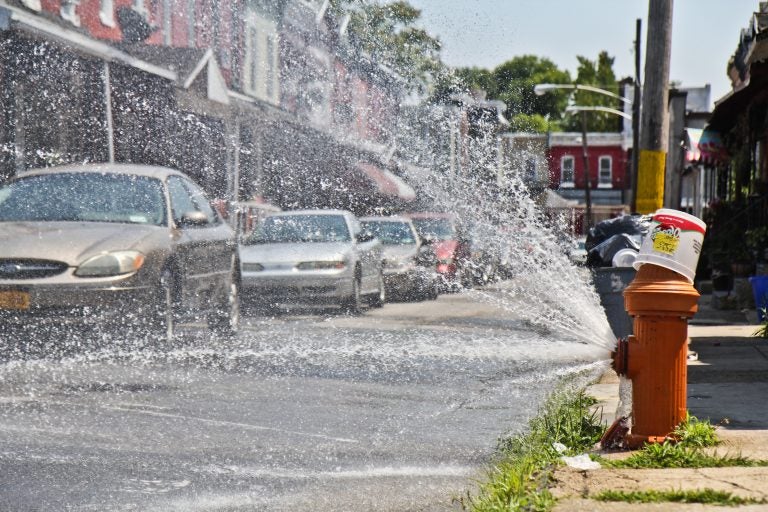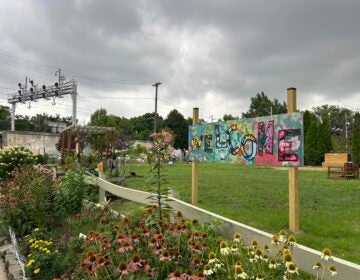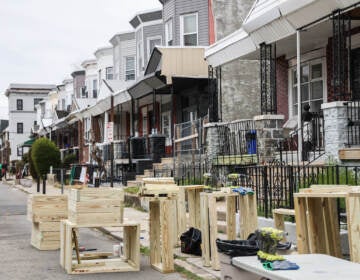Philadelphia declares a heat health emergency; scientists say more to come
Philly is under a heat health emergency this week — a new scientific report says the region will see more dangerously warm days if there's no action to cut global emissions.

File photo: Fire hydrants were opened around the city during an historic heatwave in Philadelphia in 2018. NOAA predicts higher-than-average temperatures for Philadelphia for the summer of 2022. (Kimberly Paynter/WHYY)
This article originally appeared on PlanPhilly.
—
Updated Thursday 4:10 p.m.
Philadelphia has declared a heat health emergency starting Wednesday at noon, and announced Thursday it would be extended through Monday at 11 p.m. The emergency declaration, which comes after a National Weather Service prediction of heat index values as high as 110 degrees this weekend, kicks into effect city services designed to keep people cool and safe from the dangers of excessive heat.
The announcement comes on the heels of a new report from the Union of Concerned Scientists predicting that such emergencies will become more frequent if global emissions linked to rising temperatures aren’t reduced.
Between 1971 and 2000, Philadelphia had only 4 days on average with a heat index — temperature and humidity — over 100 degrees Fahrenheit, according to the report. But in the coming decades, the city will experience sweaty days more often. The report predicts an average of 29 days in Philly with a heat index over 100 degrees between 2036 and 2065, and 16 days during that period over 105 degrees. The number of days above 100 will rise to 55 between 2070 and 2099, the report says.
Zooming out to the state level, heat will climb to 100 degrees Fahrenheit on 11 days per year on average in Pennsylvania by 2036. Delaware will see heat soar above 100 on 34 days and New Jersey, 24. The figures represent a marked change from historic heat levels. Before 2000, Pa. experienced a heat average of zero days above 100 degrees, Del. experienced five, and N.J., three.
The report used 18 climate models to project changes in the heat index in 48 states, analyzed on a very local level — a 4 by 4 kilometer basis.
It used different future emission scenarios — no substantial reductions, slow decline around mid century, and rapid action — to determine the number of dangerously warm days coming to cities, counties and states.
Union of Concerned Scientists lead climate analyst Erika Spanger-Siegfried described the trends identified in the report as “dangerous.” She said children, older and sick people and pregnant women are more affected by warmer weather, but that even healthy adults can suffer from heat-related illnesses walking around on a day over 105 degrees. Hot temperatures can cause exhaustion, cramps, and even a stroke. Three people died of heat in Philadelphia last year, according to the city’s health department.
Last year, city schools got out early five times because of the heat, a greater number than in the previous three years, according to Philadelphia School District spokesman Lee Whack. Out of 275 district buildings, only 65 have central air conditioning, 132 have window units and 11 have a combination of both — leaving 67 with no cooling system at all.
Spanger-Siegfried said all one has to do to understand how rising temperatures affect health is stand outside for an hour this weekend and imagine living in such heat for days on end. She said the report did not factor in the urban heat island effect that causes denser and less green urban areas to be hotter than rural areas, so projections for Philadelphia and other cities might even be conservative.
“Extreme heat really limits our activities, it costs our households and local economies, it threatens our health, and you know, it just makes a lot of us pretty uncomfortable, if not miserable,” she said.
The report is different than previous predictions — including those used by Philadelphia for climate adaptation plans — in that it uses the heat index, which combines temperature and humidity used as the National Weather Service as the “feel like” temperature. The study includes interactive maps of the heat projections in the country and a tool that allows users to look for the number of extremely hot days in their cities or counties.
Philadelphia’s Office of Sustainability director Christine Knapp said the report’s projections align with the city’s understanding of the risks posed by climate change.
“Heat is one of our major vulnerabilities, so we need to be preparing ourselves for what that looks like,” Knapp said. “What we know is it’s getting hotter, more of those days are coming in waves, which are more dangerous for human health, so we need to be preparing our communities and our residents for experiencing that kind of heat, and making sure that they know what they need to do to protect themselves.”
Part of the city’s plan is to activate heat emergencies like the one issued Wednesday. During these emergencies cooling centers — air conditioned libraries, recreation and senior centers — stay open for extended hours. The city also operates a heatline (215-765-9040) for residents to talk with nurses and shares information about keeping safe in the heat — drink more fluids, don’t use a fan with windows closed, stay in an air conditioned place, wear light-colored cloth. In addition, households who have fallen behind on utility bills and had utilities cut off will have their suspensions waived so they can run air conditioners.
At the same time as these emergency measures are put in place, the city is trying to address heat disparities over the long term. Temperatures in some Philly neighborhoods can climb up to 22 degrees Fahrenheit higher than in leafier neighborhoods, data collected from 2013 to 2015 show. The city’s analysis revealed that the hottest neighborhoods are also the poorest, with many of these areas lacking trees and cooling centers.
Last year, the Office of Sustainability ran a nine-month pilot program in Hunting Park, one of the most heat-vulnerable neighborhoods, to find out how residents cope with heat and what the city could do to help.
Knapp said one of the obvious findings of the pilot was the need to plant more shade trees in the neighborhood. The city also plans to create more informal cooling centers through partnerships with faith or social organization and work to get more people access to air conditioning in their homes — many residents said they didn’t use their units to avoid high electricity bills. The entire plan will be released later this month, Knapp said.
WHYY is your source for fact-based, in-depth journalism and information. As a nonprofit organization, we rely on financial support from readers like you. Please give today.







